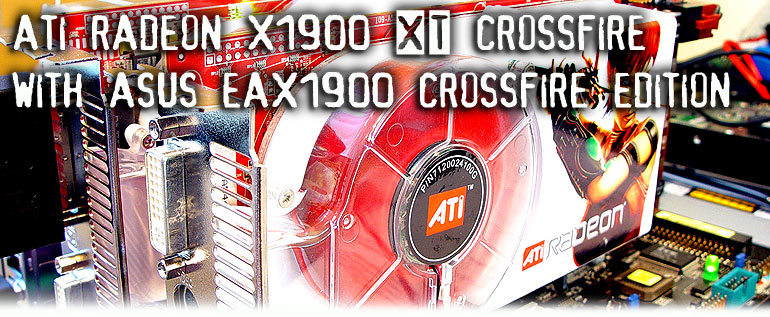Page 1

A guys dream come true, doing two of 'em !
Company: ATi technologies
info: ATI.com
Manufacturer: ASUS
Price: ~1050 USD
 Hello everyone, and welcome to Guru3D.com's most delayed article ever. Yes, this article should have been posted early February where as now it's almost April *coughs*. Today we'll bring you a long awaited review on ATI's Radeon X1900 XT Crossfire as supplied by ASUS. Now briefly let me tell you what happened over the past couple of weeks.
Hello everyone, and welcome to Guru3D.com's most delayed article ever. Yes, this article should have been posted early February where as now it's almost April *coughs*. Today we'll bring you a long awaited review on ATI's Radeon X1900 XT Crossfire as supplied by ASUS. Now briefly let me tell you what happened over the past couple of weeks.
First we had issues allocating an RD580 mainboard. Once we did allocate one we had an issue allocating another X1900 for our review. Once we allocated one we found out that there was a nasty BIOS issue with the RD580 mainboard. Once that was fixed we uncovered that *drum roll* our RD580 mainboard was broken.
So regretful .. not my style but hey this delay .. it really wasn't my fault you know ! Anyway, without further ado let me present you the products used in today's review as that well known manufacturer ASUS had a big part in today's article. To be able to handle all that luxurious rendering power ASUS supplied us with their all new ATI RD580 based A8R32-MVP Deluxe and an ASUS EAX X1900 Crossfire edition graphics card. We'll pair that card up to our reference card which is the fantastic ATI Radeon X1900 XTX 512MB.
But first things first, to the few that don't know it let me explain what terms such as SLi and Crossfire actually mean.
NVIDIA's SLI has been the company's best promotional idea since 2004. ATI on their end simply had to offer a rather bloodthirsty counter reaction which of course resulted into Crossfire. What do both solutions offer ? Two graphics cards rendering these little software applications that we call games. Why two graphics cards ? There's a number of reasons actually. It's cool, flashy, a nice experience when playing games but mostly ...it's annoying that you constantly have to upgrade your graphics card each year. Technology is moving so fast plus, well, let's face it .. the graphics chip/card manufacturers really love the fact that you need to buy a card each year. So a good alternative without spending too much money is to add a second similar generation graphics card to the one you already have in your PC and effectively double your brute rendering gaming performance. This is the concept that is ATI Crossfire. You take two similar graphics cards that you connect to each other and double up that horsepower in your PC.
There are some disadvantages .. the biggest one being your wallet as it is an incredibly expensive solution if you decide to buy the two cards at once. Next to that you'd be wise to buy a Crossfire ready mainboard or a mainboard with two x16 PCI-Express slots. Now let me sidetrack a little, here's a big advantage for ATI over NVIDIA, they do not force you the requirement of sticking to an ATI chipset based solution. Intel's 975i chipset for example can work fine also with the upcoming Catalyst 6.5 drivers (released early May).
What'll also make Crossfire expensive is the fact that you need a serious processor to be able to handle that brute force, you need a power supply that can handle all these components and you need to invest in two graphics cards. So all in all that is a rather hard struggle. It, however, is an extremely fun struggle though.
What we'll be doing today is this: We took a Crossfire mainboard (ASUS A8R32-MVP Deluxe) and started to configure it precisely the same as our main SLi graphics cards test PC to get you guys a nice overview of what Crossfire can do.
Guru's ... let the games commence !
